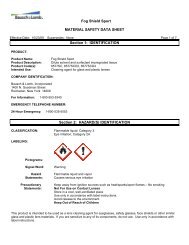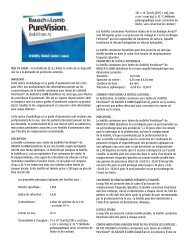Bausch & Lomb Perfecting vision, enhancing life for 150 years A ...
Bausch & Lomb Perfecting vision, enhancing life for 150 years A ...
Bausch & Lomb Perfecting vision, enhancing life for 150 years A ...
Create successful ePaper yourself
Turn your PDF publications into a flip-book with our unique Google optimized e-Paper software.
and J.J. <strong>Bausch</strong> stand in the second row, left. The metal-framed spectacles<br />
shown above feature a nosepiece of the type patented by J.J. <strong>Bausch</strong>.<br />
Page 16: 1875 <strong>Bausch</strong> & <strong>Lomb</strong> began manufacturing microscopes under the<br />
direction of Edward <strong>Bausch</strong>. A replica of the first microscope he designed is at<br />
right. Above and opposite are other early <strong>Bausch</strong> & <strong>Lomb</strong> microscopes.<br />
Page 18: 1891 <strong>Bausch</strong> & <strong>Lomb</strong> established a Mutual Benefit Association to<br />
provide insurance <strong>for</strong> its workers. Pictured are employees in the packaging<br />
department (above) and others grinding glass <strong>for</strong> lenses (opposite).<br />
Page 20: 1887 Rochester-based Eastman Kodak Company relied heavily on<br />
<strong>Bausch</strong> & <strong>Lomb</strong> to supply lenses and shutters <strong>for</strong> cameras, like the one pictured<br />
here.<br />
1887 Edward <strong>Bausch</strong>’s between-the-lenses iris diaphragm and<br />
shutter (right; detail opposite) were constructed of overlapping leaves that could<br />
be adjusted to control the amount of light admitted through the lens.<br />
Page 22: 1902 <strong>Bausch</strong> & <strong>Lomb</strong> entered the projection field with the introduction<br />
of Balopticon slide projectors (above and right).<br />
Page 23: 1902 Balopticon projectors could be used to show both transparent<br />
and opaque images. Slide shows became frequent adjuncts to lectures,<br />
presentations and even dramatic entertainments. The glass slide shown here<br />
features <strong>Bausch</strong> & <strong>Lomb</strong> factory workers on lunch break.<br />
Turbulent times, extraordinary accomplishments<br />
The year was 1905. Intent on proving that the United States was ready to take its<br />
place as a world power, President Theodore Roosevelt was building the “Great<br />
White Fleet” – sixteen new battleships that would make up the first naval fleet<br />
ever to circumnavigate the globe. The U.S. Navy’s gunsights had been produced<br />
since 1896 by the Saegmuller Company, a small instrument maker based in<br />
Washington, D.C. that bought its lenses from <strong>Bausch</strong> & <strong>Lomb</strong>. Now that the<br />
press of work had made alliance with a larger, more capable company desirable<br />
<strong>for</strong> Saegmuller, <strong>Bausch</strong> & <strong>Lomb</strong> purchased the Saegmuller Company and moved<br />
its entire operation to Rochester, thereby entering the field of optical<br />
measurement. A sign of the importance to the company of these new quantitative<br />
instruments – surveying equipment, range finders and gunsights – was that <strong>for</strong> a<br />
short time the company was renamed <strong>Bausch</strong> & <strong>Lomb</strong>-Saegmuller.<br />
The year 1905 also marked the birth of <strong>Bausch</strong> & <strong>Lomb</strong>’s Scientific Bureau,<br />
under the direction of German-trained optician A.H. Kellner. Prior to the<br />
establishment of the bureau, <strong>Bausch</strong> & <strong>Lomb</strong>’s research in optical design and in






